Natural Tips for Keeping Your Wood Floors Pristine

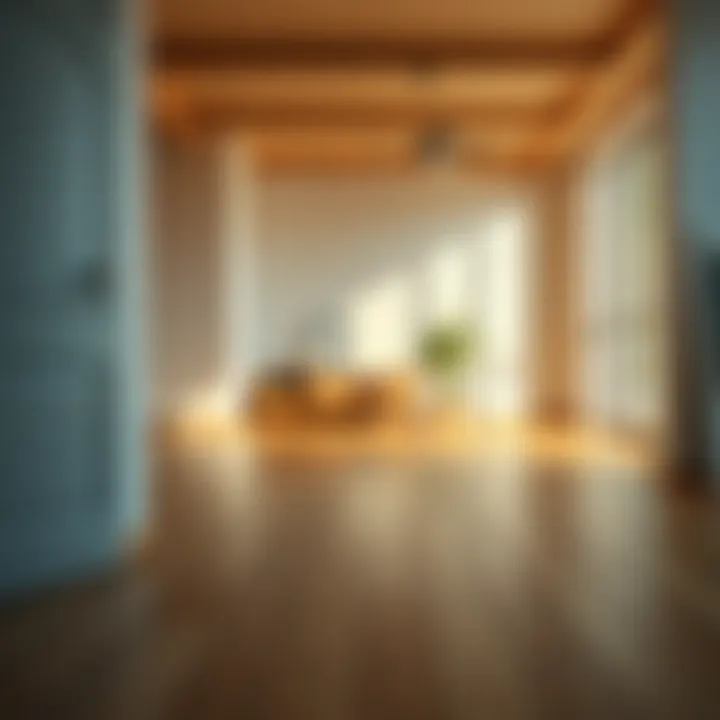
Intro
In today’s world, where the quest for sustainability is at the forefront of many discussions, maintaining our living spaces with eco-friendly practices is increasingly pertinent. When it comes to wood floors, a natural cleaning regimen does not just keep them shining; it also preserves our health and the environment. Cleaning wood floors doesn’t have to mean harsh chemicals—there are effective methods using common household items that can do the job brilliantly.
This guide will delve into various natural cleaning solutions while discussing maintenance routines that enrich your floor's beauty and longevity. From simple techniques with vinegar and baking soda to the gentle allure of olive oil and essential oils, this narrative aims to open the door to practical, green cleaning approaches that minimize chemical exposure. Let’s embark on this journey of transforming your cleaning habits into something not just effective but also environmentally conscious.
Understanding Wood Floors
Wood flooring serves as a cornerstone in home aesthetics and functionality, often leaning heavily on design trends. Yet, understanding wood floors goes beyond mere appearance; it underscores the importance of proper maintenance, cleaning methods, and the inherent value of different wood types. This knowledge creates a robust foundation for effective cleaning strategies that preserve the beauty and quality of your investment.
Types of Wood Flooring
There’s a wealth of varieties available in the market today—each with unique properties and maintenance requires. The main categories include:
- Solid Hardwood: This is the classic choice. Made from one piece of wood, solid hardwood brings durability and authenticity. Yet, it can be sensitive to moisture and temperature changes.
- Engineered Wood: Comprising multiple layers, this option offers enhanced stability. The top layer is genuine hardwood, providing the same aesthetic appeal as solid wood, while the core layers resist warping.
- Laminate: This isn't technically wood, but it mimics the look beautifully. It's resistant to scratches, making it a favorite for high-traffic areas, though it doesn't have the same feel underfoot as natural wood.
Each type necessitates specific cleaning approaches, as some may be more resilient to water than others. Understanding these differences aids in selecting the right cleaning methods that will not compromise the wood's integrity.
Characteristics of Wood Floors
Wood floors possess distinct features that impact their maintenance:
- Durability: Depending on the type of wood, floors can withstand considerable wear. For instance, oak is favored for its hardness.
- Aesthetic Appeal: Natural variations like knots and grain patterns offer a unique charm to any space.
- Sound Absorption: Wood can dampen sound better than tile or laminate, boosting comfort in living areas.
Yet, with such benefits come obligations. Regular maintenance is crucial to keep these characteristics in good shape. For example, ensuring that the wood isn't over-saturated during cleaning is essential for its longevity.
Environmental Considerations
Cleaning wood floors naturally aligns with a growing ecological consciousness. Traditional cleaning products can contain harsh chemicals that not only harm the wood but also the environment. On the flip side, natural alternatives—like vinegar or biodegradable soap—pose no threat to the surroundings or indoor air quality.
Moreover, sourcing your wood flooring sustainably can impact not just your home but global forest preservation efforts. Look for certifications like Forest Stewardship Council (FSC) to understand how the wood was sourced. Keeping this in mind encourages a holistic approach to caring for your floors while respecting Mother Earth.
"The beauty of wood lies not just in its grain, but in the stories of sustainability behind its journey to your home."
By dissecting these aspects of wood floors, readers can gain valuable insights that empower them to take informed action regarding maintenance and cleaning, ensuring their wood surfaces remain striking and durable for years to come.
Importance of Cleaning Wood Floors
Keeping wood floors clean is not just a matter of aesthetics; it's essential for preserving their beauty and longevity. With the right approaches to cleaning and maintenance, wood flooring can look stunning for years, adding to the overall appearance of your home. Not to mention, clean floors are healthier and create a welcoming environment. This section delves into several compelling reasons why cleaning wood floors should be a priority.
Aesthetic Appeal
The first thing that strikes anyone when they walk into a room is how it looks. Clean wood floors contribute significantly to the overall aesthetic of your living space. Imagine walking into a home with floors that gleam under the light, their grains and colors shining through – it’s like a work of art beneath your feet. On the flipside, dirty or dull wood floors can cast a shadow on even the most beautifully decorated room.
Regular cleaning helps remove dust, dirt, and grime that can accumulate over time. Not only does this upkeep keep your floors looking fresh, but it also accentuates the natural patterns of the wood, enhancing the design of your home. In a nutshell, clean wood floors complete the picture, creating an inviting atmosphere for family and guests alike.
Longevity of the Flooring
When it comes to wood floors, an ounce of prevention is worth a pound of cure. Regular maintenance and cleaning can significantly extend the lifespan of your flooring. Wood, being a natural material, can be sensitive to dirt and moisture. If left unchecked, dirt can scratch the surface, and moisture can lead to warping or mildew build-up.
By establishing a routine cleaning schedule, you save yourself a hefty amount of money in the long run. Consider this – regularly maintaining your wood floors could push back the need for refinishing, which can be both costly and time-consuming. The less wear and tear they experience, the longer they serve you well, helping you maximize your investment.
Health Benefits
Clean wood floors also support a healthier living environment. Allergens and dust can linger, hiding in the hard-to-reach corners of dirty floors. This can be particularly concerning for individuals with respiratory issues or allergies. An effective cleaning regimen helps eliminate these irritants, contributing to better air quality within your home.
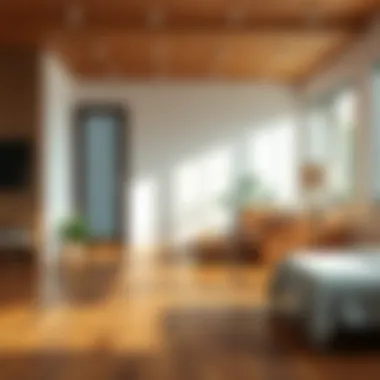

Moreover, using natural cleaning solutions helps avoid the harsh chemicals found in many commercial cleaning products. This choice doesn’t only benefit the people in your home but also protects the environment. Cleaning your wood floors with natural ingredients promotes a healthier space, reducing the risk of exposure to toxic fumes that can linger in a room.
"A home with clean wood floors isn't just beautiful; it's a sanctuary for health and well-being."
Natural Cleaning Solutions
When it comes to keeping wood floors looking tidy and polished, natural cleaning solutions play a crucial role. These methods are not just about maintaining aesthetic appeal but also about caring for the environment and ensuring health safety within our homes.
Natural cleaning solutions can prevent harsh chemicals from polluting the air and getting into our water systems. They are often derived from common household items, making them not only accessible but also economical. Using these solutions can help preserve the integrity of the wood finish, extending the life of your floors while minimizing harmful impacts.
Moreover, many of these natural cleaning remedies are backed by age-old wisdom passed down through generations. They’re straightforward to make and apply, providing an easy way to incorporate eco-friendly practices into daily life. For all these reasons, diving into the world of natural cleaning is well worth it.
Vinegar and Water Mixture
One of the simplest yet effective mixtures for cleaning wood floors is a combination of vinegar and water. Vinegar is a natural disinfectant and deodorizer, making it a go-to choice for many cleaning enthusiasts. It cuts through grime, removes odors, and even has the ability to break down residue left by some store-bought cleaners.
To create this mixture, you’ll need to mix a cup of white vinegar with a gallon of warm water. This concoction is easy to prepare and can be stored for future use in a spray bottle. However, it’s important to remember that while vinegar is fantastic for cleaning, too much acidity can harm certain wood finishes. Always consider testing on a small area first to avoid any unpleasant surprises.
"Vinegar’s natural properties allow it to clean without causing damage, maintaining the beauty of your wood floors."
Olive Oil and Vinegar
Olive oil and vinegar, while often found in kitchens for cooking, also serve as an excellent cleaning duo for wood floors. This combination not only cleans but also helps to condition and nourish the wood, giving it a lovely shine. The olive oil brings out the natural grain of the wood, providing a glossy finish without the use of chemical agents.
To use this mix, combine half a cup of olive oil with half a cup of vinegar in a spray bottle, and shake well before applying. This solution works great on a microfiber cloth, allowing you to gently buff your floors while cleaning. As with other solutions, ensure you do a spot test first to avoid disrupting any existing finishes.
Baking Soda Paste
Baking soda is another household staple that proves beneficial when it comes to cleaning wood floors. Creating a baking soda paste can help tackle tougher stains that may not budge with only vinegar and water. It’s mildly abrasive, which means it can scrub away dirt without scratching the surface of your floors.
To create this paste, simply mix baking soda with water, aiming for a spreadable consistency. Apply it directly to stains or marks and allow it to sit for a few minutes before wiping it away with a damp cloth. This method is particularly useful for scuff marks or tricky spots where dirt tends to accumulate.
Using natural cleaning solutions like vinegar and water, olive oil and vinegar, and baking soda paste helps to preserve the beauty of wood floors. These methods reflect an ethos of care, both for the home and the environment, making them deserving of consideration in one's cleaning practices.
Routine Maintenance Practices
Regular maintenance of wood floors is not just a chore, it's a commitment to preserving beauty and functionality. By adopting certain practices, homeowners can ensure their wood flooring remains in tip-top condition for many years. Understanding these routines can transform how you perceive cleaning, making it less of a task and more of a ritual of care.
Regular Dusting and Sweeping
Dust may seem harmless but it can wear away at the finish of your wood floors over time. Implementing a routine of regular dusting and sweeping is essential. A microfiber cloth or mop can do wonders, capturing dust like a magnet, while traditional dusters can often push dirt around instead of picking it up.
It's a good idea to make dusting a part of your daily routine, especially in high-traffic areas. Just fifteen minutes a day can keep the buildup at bay. This act not only enhances the look of your flooring but also catches any debris that could scratch the surface. Don’t ignore those corners and under furniture; dirt often has a tendency to settle in spots we can easily overlook.
Interval Cleaning Schedule
Maintaining a cleaning schedule is crucial in keeping wood floors healthy. It's akin to keeping a train on its tracks; without a consistent plan, it's easy to derail and let dirt accumulate. Setting a regular cleaning schedule aligns with your lifestyle. You might choose a week for light cleaning and a monthly deep cleaning. Absorbing this pattern into daily life makes cleaning less daunting.
Consider the following interval options:
- Weekly Light Cleaning: Use a damp mop with a gentle cleaner to refresh your floors without saturating the wood.
- Monthly Deep Cleaning: This is where you’ll want to give your floors a thorough going over. A steam cleaner could be your best friend here, but ensure it’s set to a low setting to prevent excess moisture.
- Seasonal Care: Every few months, check for scratches or wear and take corrective actions like recoloring or buffing. Regular assessments can save you a headache down the line.
Dealing with Spills and Stains
Spills are inevitable, especially in lively households. The first step in handling these mishaps is to act fast. The quicker you shift into cleanup mode, the less likelihood stains have to set in. Always use a soft cloth to blot rather than wipe, as wiping might push the liquid deeper into the wood.
Here are some immediate actions to take based on the type of spill:
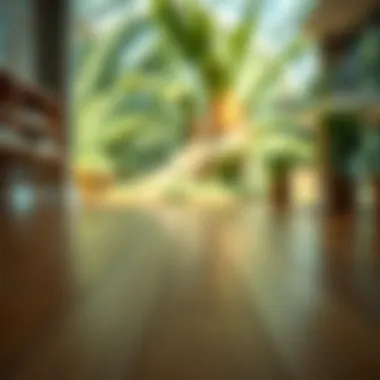
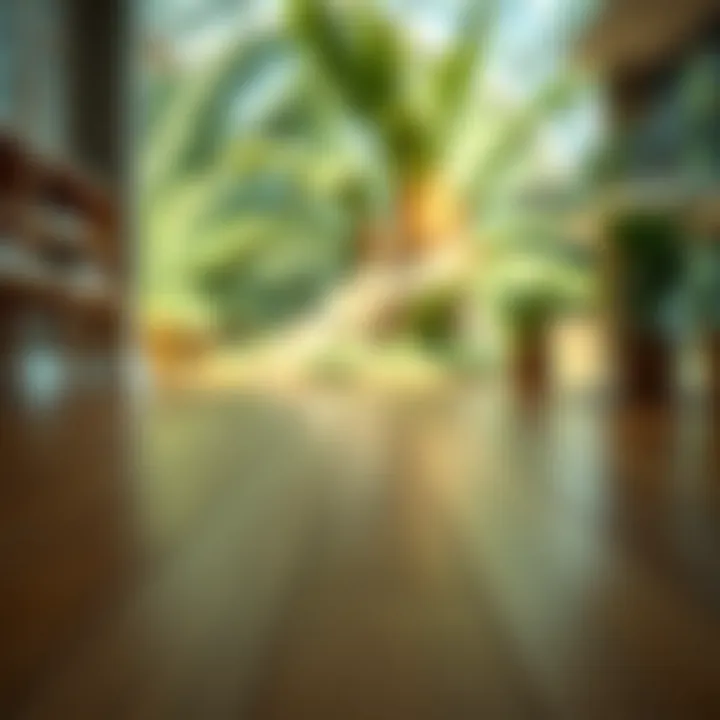
- Water: Blot it up without delay. A dry cloth can help absorb additional moisture, preventing warping.
- Food or Drink Stains: First, wipe with a damp cloth. If stains persist, a mixture of vinegar and water can effectively lift the mark, but always test a small area first.
- Oil or Grease: Sprinkle a bit of baking soda over the area and let it sit before wiping up with a clean cloth. It works like a charm without scratching.
"An ounce of prevention is worth a pound of cure." Promptly addressing spills can save a lot of trouble down the line.
By incorporating these routine maintenance practices, you'll keep your wood floors shining like the day they were installed. Not only will this enhance the aesthetic appeal of your space, it will also prolong the life of your investment. Understanding this balance is key to enjoying the natural beauty and warmth wood floors provide.
Tools for Natural Cleaning
When it comes to keeping wood floors looking pristine without the use of harsh chemicals, investing in the right tools is essential. Effective tools can make the difference between a half-hearted cleaning job and a deep, thorough cleanse that respects the natural integrity of the wood. It's not just about having tools at your disposal; it's about selecting those that enhance the cleaning process while also being environmentally friendly. Let’s explore some recommended tools that every home should have on hand for natural cleaning of wood floors.
Microfiber Mops
Microfiber mops have gained traction for their ability to trap dust, dirt, and grime more effectively than traditional mops. These mops can pick up particles that are smaller than a human hair, which is particularly useful on wood floors where minutiae can settle in crevices and scratches.
- Benefits:
- They are gentle on wood surfaces, reducing scratches compared to abrasive materials.
- Most microfiber mops come with washable heads, making them cost-efficient and eco-friendly.
- They can be used dry for dusting or wet for deeper cleaning, adapting to any cleaning scenario.
This level of versatility makes microfiber mops a staple in any household prioritizing natural floor care. With just a bit of water or a natural cleaning solution, these mops can refresh surfaces without the build-up of residues or harmful chemicals.
Natural Scrubbing Brushes
It’s no secret that some dirt or stains on wood floors may require a bit more elbow grease to tackle. Here, natural scrubbing brushes come into play, offering a firm yet safe option for aggressive cleaning.
- Considerations:
- Look for brushes made from natural fibers like palm or horsehair; these are effective without being abrasive.
- Be cautious with how much force you apply; too much scrubbing can wear down the wood finish.
With a natural scrubbing brush, you can tackle stubborn spots that don’t budge with a simple mop. Combined with a gentle cleaning solution, they can rejuvenate even the most stained areas, prolonging the life of the flooring.
Sustainable Cleaning Cloths
Using the right cloth can change the game when it comes to wood floor care. Sustainable cleaning cloths, often made from organic cotton or bamboo, serve as great alternatives to disposable options.
- Advantages:
- They are reusable and can be tossed in the wash, minimizing waste.
- Soft cloths prevent scratching that can arise from harsher materials, ensuring the finish remains intact.
- These cloths can effectively soak up spills or wipe down surfaces without leaving lint behind, ensuring a spotless look.
Sustainability plays a huge role in today’s cleaning choices. By selecting these cloths, not only do you maintain your floors, but you also contribute to environmental efforts.
"Using the right tools is fundamental to ensuring your wood floors remain beautiful and durable. Natural cleaning methods paired with smart tools can lead to squeaky clean—without the fuss of chemicals!"
When cleaning wood floors, the tools you use can either hinder or enhance your efforts. Opting for the right items—a microfiber mop, natural scrubbing brush, and sustainable cleaning cloths—can help you maintain the charm of your wooden surfaces while holding true to your eco-friendly principles.
Advanced Techniques for Stubborn Dirt
When it comes to keeping wood floors pristine, stubborn dirt can be quite the adversary. This section will shed light on advanced techniques that elevate your cleaning game. Understanding the unique characteristics of stains and dirt on wood surfaces is crucial. Substances like grease, pet urine, and even dirt tracked in from outside require more than just a simple mopping. Incorporating specialized methods into your regular cleaning routine not only restores the beauty of your floors but also prolongs their lifespan.
Essential Oils for Cleaning
Essential oils are not just for aromatherapy; many have cleaning properties that can tackle stubborn dirt effectively. Oils like tea tree, lavender, and lemon have antibacterial benefits and can add a pleasant scent to your home. Here’s how you can utilize these oils:
- Mixing a Solution: Combine a few drops of tea tree oil with water in a spray bottle. This mix acts as a natural disinfectant, tackling mold and mildew.
- Enhancing Cleaning Solutions: When using your vinegar-water mix, a few drops of lemon oil can enhance its stain-fighting properties.
- Routine Refresh: A cotton cloth soaked in lavender oil can wipe down surfaces, leaving a fresh aroma while also ensuring cleanliness.
The benefits of using essential oils extend beyond aesthetics; they also promote a healthier living environment, devoid of harsh chemicals often found in commercial cleaners.
Steam Cleaning Options
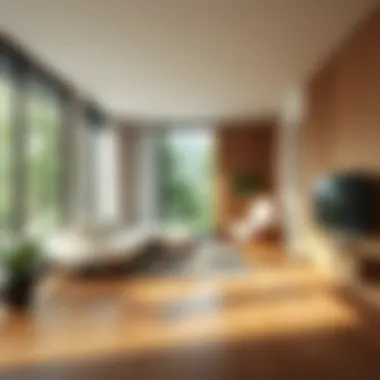
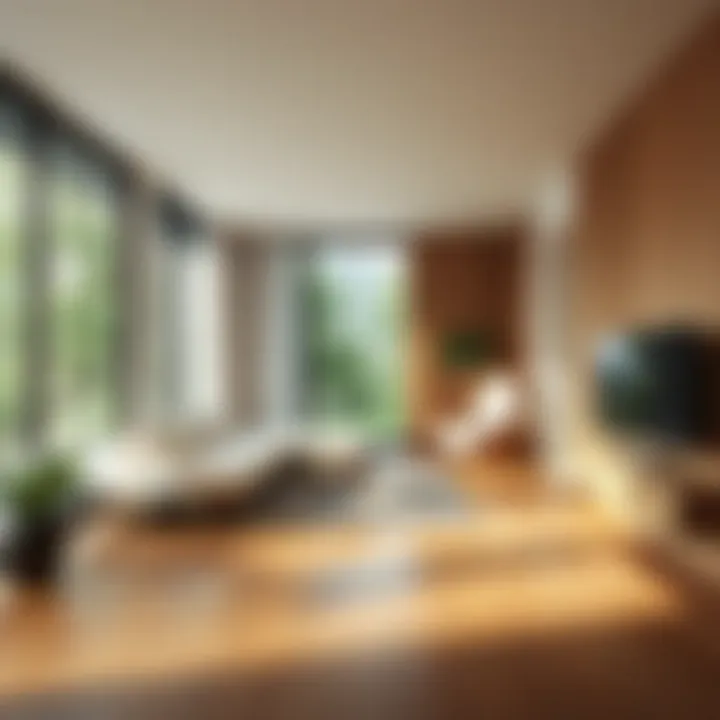
Steam cleaning has become a hot topic in cleaning circles, and for good reason. It’s effective for removing deeply embedded dirt without using aggressive chemicals. Here are some points to consider:
- How It Works: Steam mops heat water to create steam, which penetrates the wood’s surface. This effectively loosens dirt and grime, enabling easy wipe-up.
- Frequency: It's wise to use steam cleaning sparingly. Too much moisture can damage wood floors, so aim for once a month or as needed.
- Preparation: Before steam cleaning, ensure to sweep or vacuum to remove any larger debris that could scratch the surface when steam is applied.
Steam cleaning proves invaluable, especially for high-traffic areas. However, it is best suited for sealed or finished wood, as it might not be ideal for raw wood surfaces.
Natural Wax Finishing
Maintaining the luster of your wood floors can sometimes require a finishing touch. Natural wax is an excellent option for rejuvenating and protecting your surface. Not only does it fill in scratches, but it also adds a layer of resistance against the elements. Here’s how to incorporate natural wax:
- Choosing the Right Wax: Look for beeswax or carnauba wax, both of which are sustainable and eco-friendly.
- Application: After cleaning, buff the wax onto your floor using a soft cloth. This not only polishes but helps reinforce the surface against dirt.
- Reapplication Cycle: Depending on foot traffic, consider reapplying every few months to keep the finish looking vibrant and fresh.
Natural wax finishing not only enhances the visual appeal but also provides a protective barrier—ensuring your wood floors remain stunning while standing up to life’s wear and tear.
"Using advanced methods like essential oils, steam cleaning, and natural wax not only cleans your floors but also creates a fresh and inviting home environment."
Precautions with Natural Cleaning
When embracing the delightful world of natural cleaning methods for wood floors, it's crucial to tread carefully. While these methods are eco-friendly and often safer than conventional cleaners, each wood floor is as unique as the tree it came from. Recognizing this diversity helps ensure that our approach to cleaning doesn’t lead to unintended consequences.
Avoiding Harmful Substances
Our kitchens and pantries are treasure troves of natural cleaning ingredients, but it’s important to remember that not all substances are created equal. For instance, while vinegar works wonders for many surfaces, it’s best avoided on waxed floors, as it may strip the finish. Additionally, some essential oils, though aromatic and relaxing, can be too harsh or cause a discoloration effect on certain wood types.
- Stay clear of:
- Colored or synthetic cleaners: Even if they claim to be environmentally friendly, they often contain additives that may not be safe for wood finishes.
- Scouring agents: These can scratch and dull your floor. Instead, using gentle alternatives will protect your wood over time.
Choosing the right items is paramount. By carefully selecting your cleaning agents, you not only maintain the gleam of your wood floors but minimize exposure to substances that might be harmful.
Test Before Application
Always remember the golden rule of cleaning: what works for one surface may not work for another. Before applying any cleaning solution to your beautiful flooring, it’s wise to perform a spot test. Choose a less noticeable area to determine if any adverse reactions might occur. This approach saves you from a potential heartache down the road.
For testing, follow these steps:
- Pick your solution: Whether you're opting for vinegar, baking soda, or a unique concoction, make sure it's diluted if necessary.
- Apply a small amount: Use a cotton ball or a clean cloth with your selected mixture on the test area.
- Wait for a few minutes: Give it time to interact with the surface.
- Check for discoloration: If you observe no changes or negative effects, it's likely safe to use the cleaner across larger areas.
This careful diligence in the testing phase can save you time and money and ensure your wood floors remain stunning for years to come.
Understanding Wood Finish Compatibility
One of the many things that can influence cleaning routines is the type of finish on your wood floor. There’s a world of differences between oil-based, water-based, and wax finishes. Recognizing these distinctions is crucial in deciding how best to clean and maintain your flooring.
- Oil-based finishes generally require more gentle cleaning methods. Regular dusting is often sufficient, and water should be used sparingly to avoid damage.
- Water-based finishes tend to be more resilient but can still be harmed by excess moisture. This means damp mops, not soaking wet ones.
- Wax finishes require unique attention because they need occasional re-waxing. Products containing wax or oils may be beneficial, but avoid anything too abrasive.
When in doubt, consult the manufacturer’s recommendations or labels for insights into maintaining and cleaning your particular flooring type. Understanding these compatibilities not only extends the life of your wood floors but also keeps them looking their best.
Natural cleaning methods can be highly effective, but knowledge is your best ally in safeguarding the beauty of your wood floors.
Closure
Summarizing Key Points
Reflecting on what we’ve covered, here are key takeaways:
- Natural Cleaning Solutions: Vinegar and water mixtures, along with baking soda pastes, are effective alternatives to chemical-laden cleaners. They accomplish the same results without the toxic residues, keeping your home safer for both people and pets.
- Routine Maintenance: Regular dusting and sweeping is not to be underestimated. A consistent cleaning schedule can greatly lessen the day-to-day muck that can accumulate on wood floors. Ideally, creating a simple weekly or bi-weekly routine helps prolong the shine and quality of the wood finish.
- Tools Matter: Utilizing the right tools, like microfiber mops or natural scrubbing brushes, makes the cleaning process effective and efficient. These tools can make all the difference in achieving that natural luster without scratching the surface of your floors.
Encouragement for Natural Cleaning
As we conclude, it’s important to remind you that maintaining clean wood floors doesn’t have to be a chore filled with fumes and harmful substances. Next time you face a mess, consider reaching for those household staples. Not only will your floors thank you, but your family’s health will benefit as well. Try incorporating these natural methods into your cleaning routine—over time, you might find them easier on the wallet and a breeze to utilize.
Be the steward of your home, allowing it to gleam and effuse warmth, all while standing consistent with environmentally mindful practices. Taking this path enhances your living space and fosters a connection to the natural resources around us, ultimately enriching your environment like a breath of fresh air.



